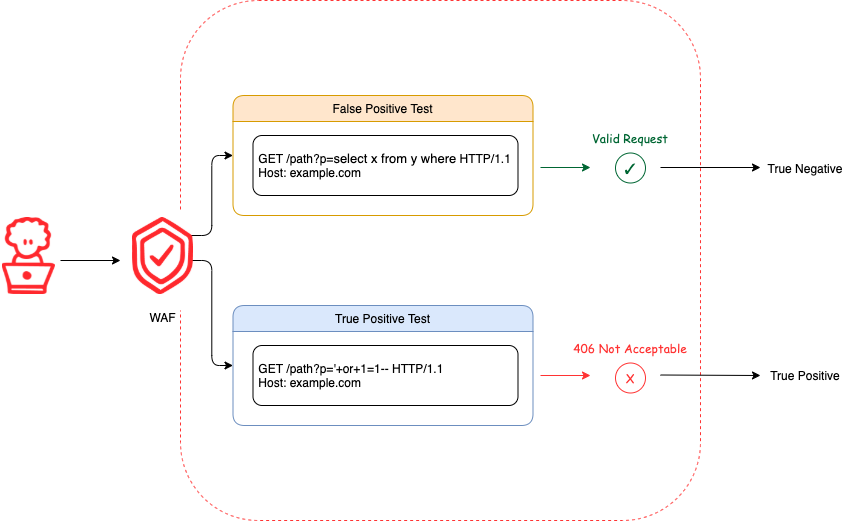The WAF efficacy framework provides a standardized way to measure the effectiveness of a WAF’s detection capabilities. It provides the ability to perform continuous assessments of simulated attacks to test different attack types and distills the results into an overall score that can be used for point in time knowledge or trends of effectiveness. This project contains some initial code and templates to get started.
Before performing an efficacy test you’ll need to ensure the WAF you’re testing against is configured to block attacks and a response status code is set that is used for blocked requests. By default, it checks for the receipt of “406 Not Acceptable” when a request is blocked.
Build the project using the go build command. This command will compile your Go code into an executable binary.
go buildUsage:
wafefficacy run [flags]
Flags:
--attacks strings list of attack types (default [cmdexe,sqli,traversal,xss])
-c, --config string path to the nuclei configuration file (default "config.yaml")
-h, --help help for run
-r, --response string WAF response for blocked requests (default "406 Not Acceptable")
-u, --target string target URL/host to scan
-t, --template-dir string path to the nuclei template directory (default "nuclei-templates")
-v, --verbose verboseThis project utilizes Nuclei to augment the manual, repetitive process of simulating attacks through the use of YAML-based templates. We've included boilerplate examples for Command Execution cmdexe, SQL Injection sqli, Traversal traversal, and Cross-Site Scripting xss.
The project contains a directory called nuclei that has two subdirectories. One for payloads and one for templates. For each attack type we define two templates and two sets of payloads. One template and corresponding payload list for true positives and another template and corresponding payload list for false positives.
- A true positive test will test if a legitimate attack was correctly identified as malicious.
- A false positive test will test if an acceptable payload is incorrectly identified as malicious.
Each payload is injected into the payload positions of requests as defined in the templates. All requests are recorded and logged in JSON format. The logs include request/response pairs and additional metadata.
In order to determine whether the WAF correctly identified a request as malicious or not, we key off of the response status code. It defaults to look for the receipt of "406 Not Acceptable" when a request is blocked.
In the case of a true positive test, if a 406 response is received, that is counted as a true positive. If the response doesn't contain a 406 response then it's counted as a false negative.
In the case of a false positive test, if a 406 response is received, that is counted as a false positive. If the response doesn't contain a 406 response then it's counted as a true negative.
The results are then calculated to provide efficacy scores for each attack type and overall.
If you would like to add a new attack type to the testing framework you can start by creating new subdirectory with the abbreviated attack name under nuclei-templates/http and nuclei-templates/helpers/payloads.
For instance if you want to include tests for Server-side request forgery (SSRF) you'll add ssrf as a sub directory.
mkdir nuclei-templates/http/ssrf && mkdir nuclei-templates/helpers/payloads/ssrf
Then create and populate two lists of attack payloads, one for true positives and false positives.
touch nuclei-templates/helpers/payloads/ssrf/true-positives.txt && touch nuclei-templates/helpers/payloads/ssrf/false-positives.txt
Then create two nuclei templates, one for true positives and false positives.
touch nuclei-templates/http/ssrf/true-positives.yaml && touch nuclei-templates/http/ssrf/false-positives.yaml
Each template has a template ID which is a unique ID used to specify the template name for a request type. We use the naming convention of attack type followed by the name of the test type. In our case we define a SSRF true positive template id as followed:
id: ssrf-true-positiveThe next piece of information of the template is the info block. The info block supports dynamic fields, so you can define N number of key: value blocks to provide more useful information about the template. For our purposes we only provide name, author, severity, and tags. author and severity are required fields. If they’re not specified you’ll encounter issues running your tests.
id: ssrf-true-positive
info:
name: Server-side request forgery (SSRF)
author: wafefficacy
severity: info
tags: ssrf,true-positivePayloads are defined under the payloads field beneath the info block and the actual requests are placed below. Each template can contain multiple requests that test payloads in various ways. Let’s build out our template a bit more using this information:
id: ssrf-true-positive
info:
name: Server-side request forgery (SSRF)
author: wafefficacy
severity: info
tags: ssrf,true-positive
http:
- raw:
- |
GET /anything?p={{url_encode(ssrf)}} HTTP/1.1
Host: {{Hostname}}
Connection: close
- |
POST /anything HTTP/1.1
Host: {{Hostname}}
Content-Type: application/x-www-form-urlencoded
Connection: close
p={{url_encode(ssrf)}}
payloads:
ssrf: helpers/payloads/ssrf/true-positives.txtIn order to validate tests, Nuclei makes use of something called matchers. Matchers allow for flexible comparison of responses that determine whether a test passed or failed. However, for our purposes we want to match everything. This is because the Nuclei logs include request/response pairs and additional metadata. So in our use case, we’ll match every request that doesn’t contain a status code of 1. Since 1 is not a valid server response code we’ll never receive that response, and as a result match every request.
The complete template will be as followed:
id: ssrf-true-positive
info:
name: Server-side request forgery (SSRF)
author: wafefficacy
severity: info
tags: ssrf,true-positive
http:
- raw:
- |
GET /anything?p={{url_encode(ssrf)}} HTTP/1.1
Host: {{Hostname}}
Connection: close
- |
POST /anything HTTP/1.1
Host: {{Hostname}}
Content-Type: application/x-www-form-urlencoded
Connection: close
p={{url_encode(ssrf)}}
payloads:
ssrf: helpers/payloads/ssrf/true-positives.txt
matchers:
- type: status
status:
- 1
negative: trueTo see if future runs of your efficacy test regress, use e.g. -o efficacy.json to save the current efficacy percentages to a json file.
Then pass that file to future runs with the -i parameter, e.g. -i assertions.json, to abort if efficacy for any attack type (or overall) falls below that in the file.
Example file:
{"cmdexe": 60, "sqli": 70, "traversal": 80, "xss": 90, "overall": 75}For historical comparisons and insights we recommend exporting the results to a backend of your choice.
